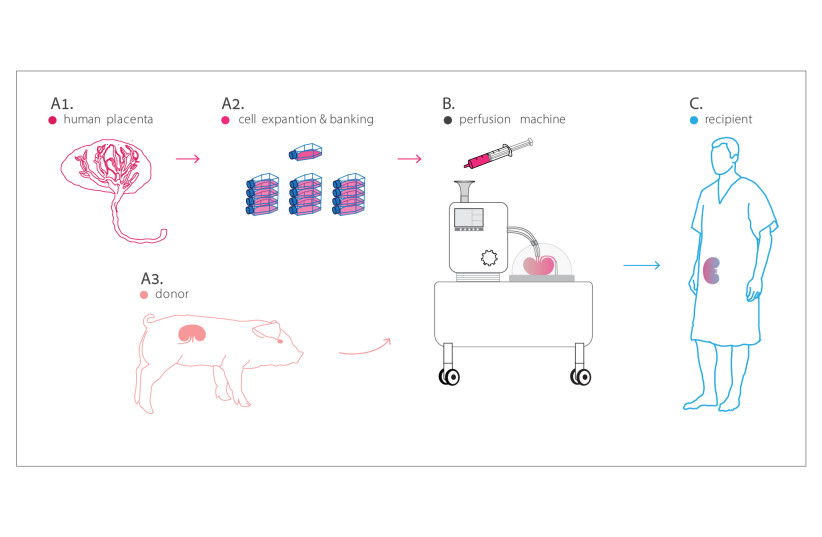Imagine a world where a person experiencing the first stages of kidney failure could simply get a replacement organ like a car owner would purchase a new engine from the shop.
According to Dr. Shahar Cohen, such a scenario is likely less than a decade off.
“Wouldn’t a 100-year-old person benefit from a new organ even if it is not failing?” Cohen, who runs Nayacure Labs, asked. “If organ transplantation was safer and more available, you could replace organs as part of a maintenance plan to prevent disease.”
It is just one idea of many that sound like science fiction but are quickly becoming reality through the work of doctors and scientists in the field of regenerative medicine.
As people are expected to live until 100 and beyond, there are efforts underway to make that viable without having to sacrifice too much quality of life, Cohen said.
“Living longer and healthier is something people are actually talking about,” he told The Jerusalem Post. “Aging is being considered a disease that can be cured rather than something that is inevitable and normal.”
There are several examples of these efforts, such as using CRISPR technology to modify the sequence of DNA to replace abnormal or bad parts of the DNA or insert good missing genes.
Other research focuses on connecting the human nervous system to machines; others focus on using big data and AI to generate insights toward the prevention and treatment of many diseases.
Cohen’s bioengineering lab is working on a project it calls “organs on demand,” which takes an engineering approach to tackle immune rejection that results from organ transplantation.
“Our goal is to generate an unlimited supply of human-compatible organs to address the global shortage of organs available for transplantation,” he said.
To do so, Cohen and his team are using advanced tissue engineering techniques to replace the innermost layer of the donor blood vessels – in this case, a pig – with non-immunogenic human cells, paving the way to generate transplantable, fully functional organs.

The main trigger of organ rejection is the internal lining of its blood vessels, Cohen said. This coating is the point of contact between the transplanted organ and the recipient’s body.
“We looked for a way to produce an alternative coating that does not cause rejection,” he explained.
The solution: Cohen’s team removed the coating from the pigs’ blood vessels and replaced it with a more “friendly” coating to the human immune system that was engineered in the laboratory from human placenta cells, which, as far as is known, do not trigger rejection.
“We remove the pig’s internal layer of blood vessels and replace it with a ‘human layer,’ thereby humanizing the blood vessels of the organ and generating a hybrid organ – a pig organ with humanized blood vessels,” Cohen said. “This is the way to surmount the barrier to pig organs in humans.”
The method has been successfully tried so far in a number of organs and limbs, including the heart, lungs, liver, kidney and pancreas, he said. The experiments until now were ex vivo, meaning outside the body.
Cohen’s research was recently published in the peer-reviewed Scientific Reports, a Nature Portfolio research journal.
Eventually, Cohen believes the process will work to replace other types of body parts, including limbs, wombs and even faces, which today is almost impossible – not because the transplantation is difficult, but mostly due to acute rejections.
“This is something that makes a lot of sense if you consider the need,” Cohen said. “Look at the numbers: There is a mass shortage of transplantable organs.”
In the US alone, someone is added to the organ waiting list every 10 minutes. Some 20 people die each day waiting for a life-saving transplant. The need is even greater since countless more people in need of organ transplants don’t even get on the waiting lists before they die of organ failure.
Furthermore, Cohen said, an estimated 35% of US deaths could be prevented if people had unlimited access to organ transplants.
“The need is huge, and the opportunity is huge, as well,” he said. “If you could change it so that the person’s body does not reject the pig organ, you could transform everything as we know it.”
Cohen said he plans to work with third-party pig manufacturers that would grow and breed pigs that are safer for human use, and the organs could then be ready on demand.
“You do not need many pigs to solve the global shortage,” he stressed. “In the US alone, there are more than 100 million pigs being used for the food industry, and you need less than 1% of them to get an unlimited supply of organs to solve the global shortage.”
Cohen said he believes the first human trials for his pig transplant process will begin within three to five years.
“We really live in really exciting times,” he said. “All of these technologies are advancing really fast. We believe that our technology provides a significant shortcut in the efforts to generate an unlimited supply of transplantable organs that will be available on demand.
“The future is here,” Cohen said. “The future is now.”
